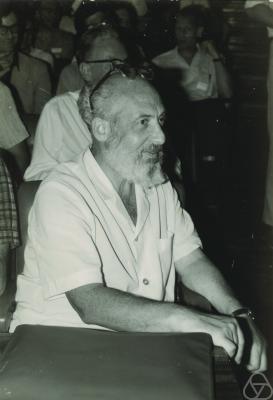In commutative algebra, the prime spectrum of a commutative ring is the set of all prime ideals of , and is usually denoted by ; in algebraic geometry it is simultaneously a topological space equipped with the sheaf of rings .

In mathematics, the Hodge conjecture is a major unsolved problem in algebraic geometry and complex geometry that relates the algebraic topology of a non-singular complex algebraic variety to its subvarieties.
In mathematics, a symplectomorphism or symplectic map is an isomorphism in the category of symplectic manifolds. In classical mechanics, a symplectomorphism represents a transformation of phase space that is volume-preserving and preserves the symplectic structure of phase space, and is called a canonical transformation.

Samuel Eilenberg was a Polish-American mathematician who co-founded category theory and homological algebra.
In mathematics, the étale cohomology groups of an algebraic variety or scheme are algebraic analogues of the usual cohomology groups with finite coefficients of a topological space, introduced by Grothendieck in order to prove the Weil conjectures. Étale cohomology theory can be used to construct ℓ-adic cohomology, which is an example of a Weil cohomology theory in algebraic geometry. This has many applications, such as the proof of the Weil conjectures and the construction of representations of finite groups of Lie type.
Algebraic K-theory is a subject area in mathematics with connections to geometry, topology, ring theory, and number theory. Geometric, algebraic, and arithmetic objects are assigned objects called K-groups. These are groups in the sense of abstract algebra. They contain detailed information about the original object but are notoriously difficult to compute; for example, an important outstanding problem is to compute the K-groups of the integers.
In mathematics, the Thompson groups are three groups, commonly denoted , that were introduced by Richard Thompson in some unpublished handwritten notes in 1965 as a possible counterexample to the von Neumann conjecture. Of the three, F is the most widely studied, and is sometimes referred to as the Thompson group or Thompson's group.
In mathematics, the Lyusternik–Schnirelmann category of a topological space is the homotopy invariant defined to be the smallest integer number such that there is an open covering of with the property that each inclusion map is nullhomotopic. For example, if is a sphere, this takes the value two.
In mathematics, in the subfield of geometric topology, the mapping class group is an important algebraic invariant of a topological space. Briefly, the mapping class group is a certain discrete group corresponding to symmetries of the space.
In an area of mathematics called differential topology, an exotic sphere is a differentiable manifold M that is homeomorphic but not diffeomorphic to the standard Euclidean n-sphere. That is, M is a sphere from the point of view of all its topological properties, but carrying a smooth structure that is not the familiar one.
In mathematics, the Seifert conjecture states that every nonsingular, continuous vector field on the 3-sphere has a closed orbit. It is named after Herbert Seifert. In a 1950 paper, Seifert asked if such a vector field exists, but did not phrase non-existence as a conjecture. He also established the conjecture for perturbations of the Hopf fibration.

In mathematics, systolic geometry is the study of systolic invariants of manifolds and polyhedra, as initially conceived by Charles Loewner and developed by Mikhail Gromov, Michael Freedman, Peter Sarnak, Mikhail Katz, Larry Guth, and others, in its arithmetical, ergodic, and topological manifestations. See also Introduction to systolic geometry.
In mathematics, the J-homomorphism is a mapping from the homotopy groups of the special orthogonal groups to the homotopy groups of spheres. It was defined by George W. Whitehead, extending a construction of Heinz Hopf.
In geometric topology, the Borel conjecture asserts that an aspherical closed manifold is determined by its fundamental group, up to homeomorphism. It is a rigidity conjecture, asserting that a weak, algebraic notion of equivalence should imply a stronger, topological notion.
Tudor Ganea was a Romanian-American mathematician, known for his work in algebraic topology, especially homotopy theory. Ganea left Communist Romania to settle in the United States in the early 1960s. He taught at the University of Washington.
The Eilenberg–Ganea conjecture is a claim in algebraic topology. It was formulated by Samuel Eilenberg and Tudor Ganea in 1957, in a short, but influential paper. It states that if a group G has cohomological dimension 2, then it has a 2-dimensional Eilenberg–MacLane space . For n different from 2, a group G of cohomological dimension n has an n-dimensional Eilenberg–MacLane space. It is also known that a group of cohomological dimension 2 has a 3-dimensional Eilenberg−MacLane space.
In the mathematics of moduli theory, given an algebraic, reductive, Lie group and a finitely generated group , the -character variety of is a space of equivalence classes of group homomorphisms from to :
In mathematics, particularly in homological algebra and algebraic topology, the Eilenberg–Ganea theorem states for every finitely generated group G with certain conditions on its cohomological dimension, one can construct an aspherical CW complex X of dimension n whose fundamental group is G. The theorem is named after Polish mathematician Samuel Eilenberg and Romanian mathematician Tudor Ganea. The theorem was first published in a short paper in 1957 in the Annals of Mathematics.
This is a glossary of properties and concepts in algebraic topology in mathematics.
In metric geometry, asymptotic dimension of a metric space is a large-scale analog of Lebesgue covering dimension. The notion of asymptotic dimension was introduced by Mikhail Gromov in his 1993 monograph Asymptotic invariants of infinite groups in the context of geometric group theory, as a quasi-isometry invariant of finitely generated groups. As shown by Guoliang Yu, finitely generated groups of finite homotopy type with finite asymptotic dimension satisfy the Novikov conjecture. Asymptotic dimension has important applications in geometric analysis and index theory.


















